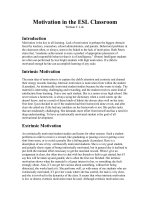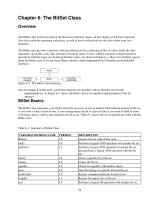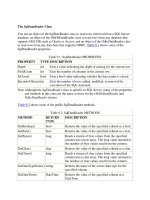The SqlDataAdapter Class
Bạn đang xem bản rút gọn của tài liệu. Xem và tải ngay bản đầy đủ của tài liệu tại đây (37.1 KB, 6 trang )
The SqlDataAdapter Class
You use an object of the SqlDataAdapter class to synchronize data stored in a DataSet
object with a SQL Server database. You use an object of the OleDbDataAdapter class to
synchronize data with a database that supports OLE DB, such as Oracle or Access. You
use an object of the OdbcDataAdapter class to synchronize data with a database that
supports ODBC.
Note Although the SqlDataAdapter class is specific to SQL Server, many of the
properties and methods in this class are the same as those for the
OleDbDataAdapter and OdbcDataAdapter classes.
Table 10.1
shows some of the SqlDataAdapter properties.
Table 10.1: SqlDataAdapter PROPERTIES
PROPERTY TYPE DESCRIPTION
AcceptChangesDuringF
ill
bool Gets or sets a bool that indicates
whether the AcceptChanges()
method is called after a DataRow
object has been added, modified,
or removed in a DataTable object.
The default is true.
ContinueUpdateOnError bool Gets or sets a bool that indicates
whether to continue updating the
database when an error occurs.
When set to true, no exception is
thrown when an error occurs
during the update of a row. The
update of the row is skipped and
the error information is placed in
the RowError property of the
DataRow that caused the error.
The DataAdapter continues to
update subsequent rows.
When set to false, an exception is
thrown when an error occurs. The
default is false.
DeleteCommand SqlCommand Gets or sets a command containing
Table 10.1: SqlDataAdapter PROPERTIES
PROPERTY TYPE DESCRIPTION
a SQL DELETE statement or
stored procedure call to remove
rows from the database.
InsertCommand SqlCommand Gets or sets a command containing
a SQL INSERT statement or
stored procedure call to add rows
to the database.
MissingMappingAction MissingMappingAction Gets or sets the action to take
when the incoming table or
column doesn't have a matching
table or column in the
TableMappings collection.
The values for this action come
from the
System.Data.MissingMappingActi
on enumeration with the members
Error, Ignore, and Passthrough:
•
Error means a
SystemException is thrown.
•
Ignore means the table or
column is ignored and not
read.
•
Passthrough means the
table or column is added to
the DataSet with its original
name.
The default is Passthrough.
MissingSchemaAction MissingSchemaAction Gets or sets the action to take
when the incoming column doesn't
have a matching column in the
DataTable object's Column
collection.
The values for this action come
from the
System.Data.MissingSchemaActio
Table 10.1: SqlDataAdapter PROPERTIES
PROPERTY TYPE DESCRIPTION
n enumeration with the members
Add, AddWithKey, Error, and
Ignore:
•
Add means the column is
added to the DataTable.
•
AddWithKey means the
column and primary key
information is added to the
DataTable.
•
Error means a
SystemException is thrown.
•
Ignore means the column is
ignored and not read.
The default is Add.
SelectCommand SqlCommand Gets or sets a command containing
a SQL SELECT statement or
stored procedure call to retrieve
rows from the database.
TableMappings DataTableMappingCollecti
on
Gets a
DataTableMappingCollection that
contains the mapping between a
database table and a DataTable
object in the DataSet.
UpdateCommand SqlCommand Gets or sets a command containing
a SQL UPDATE statement or
stored procedure call to modify
rows in the database.
Table 10.2 shows some of the SqlDataAdapter methods.
Table 10.2: SqlDataAdapter METHODS
METHOD RETURN TYPE DESCRIPTION
Fill() int Overloaded. Synchronizes the rows in the
DataSet object to match those in the database.
The int returned by this method is the number of
rows synchronized in the DataSet with the
Table 10.2: SqlDataAdapter METHODS
METHOD RETURN TYPE DESCRIPTION
database.
FillSchema() DataTable
DataTable[]
Overloaded. Adds a DataTable to a DataSet
object and configures the schema to match the
database.
GetFillParameters() IDataParameter[] Returns an array of any parameters set for the
SQL SELECT statement.
Update() int Overloaded. Calls the respective SQL INSERT,
UPDATE, or DELETE statements or stored
procedure call (stored in the InsertCommand,
UpdateCommand, and DeleteCommand
properties, respectively) for each row that has
been added, modified, or removed from a
DataTable object. The int returned by this method
is the number of rows updated.
Table 10.3 shows some of the SqlDataAdapter events.
Table 10.3: SqlDataAdapter EVENTS
EVENT EVENT HANDLER DESCRIPTION
FillError FillErrorEventHandler Fires when an error occurs during a fill
operation.
RowUpdating RowUpdatingEventHandler Fires before a row is added, modified, or
deleted in the database.
RowUpdated RowUpdatedEventHandler Fires after a row is added, modified, or
deleted in the database.
You'll learn how to use some of these properties and methods to store data in DataSet
objects in this chapter. You'll see how to use the other properties, methods, and the events
in Chapter 11
, in which you'll learn how to modify data in DataSet objects, and then push
those modifications to the database.
Creating a SqlDataAdapter Object
You create a SqlDataAdapter object using one of the following SqlDataAdapter
constructors:
SqlDataAdapter()
SqlDataAdapter(SqlCommand mySqlCommand)
SqlDataAdapter(string selectCommandString, SqlConnection mySqlConnection)
SqlDataAdapter(string selectCommandString, string connectionString)
where
mySqlCommand specifies your SqlCommand object.
selectCommandString specifies your SELECT statement or stored procedure call.
mySqlConnection specifies your SqlConnection object.
connectionString specifies your connection string to connect to the database.
The following example uses the SqlDataAdapter() constructor to create a SqlDataAdapter
object:
SqlDataAdapter mySqlDataAdapter = new SqlDataAdapter();
Before using mySqlDataAdapter to populate a DataSet, you must set its SelectCommand
property to a SqlCommand that contains a SELECT command or stored procedure call.
The following example creates a SqlCommand object with its CommandText property set
to a SELECT statement that will retrieve the top five rows from the Products table, and
sets the CommandText property of mySqlDataAdapter to that SqlCommand object:
SqlCommand mySqlCommand = mySqlConnection.CreateCommand();
mySqlCommand.CommandText =
"SELECT TOP 5 ProductID, ProductName, UnitPrice " +
"FROM Products " +
"ORDER BY ProductID";
mySqlDataAdapter.SelectCommand = mySqlCommand;
The next example uses the SqlDataAdapter(SqlCommand mySqlCommand) constructor:
SqlDataAdapter mySqlDataAdapter = new SqlDataAdapter(mySqlCommand);
The next example uses the SqlDataAdapter(string selectCommandString, SqlConnection
mySqlConnection) constructor:
SqlConnection mySqlConnection =
new SqlConnection(
"server=localhost;database=Northwind;uid=sa;pwd=sa"
);
string selectCommandString =









